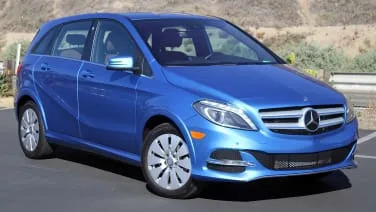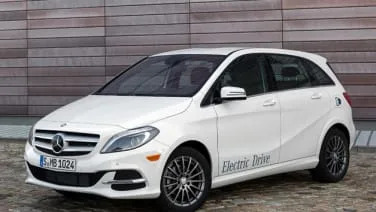2015 Mercedes-Benz B-Class Electric Drive
The sandwich floor at the bottom of the Mercedes-Benz B-Class first appeared with the introduction of the A-Class in 1997. At the time, Mercedes stressed that the floor's design was for crash safety, allowing the engine and driveline components to slide under the forward occupants in an accident. To the current point, the Germans said this design would one day be suitable for fitting alternative powertrains in mainstream cars – like batteries for an electric vehicle.It took 17 years, but the evolution of that design exists today in the fully electric Mercedes-Benz B-Class. The result is a fine electric car with one major flaw. We're talking about the absolutely confounding charger. Two cords emerge from either side of a box containing about 10 pounds of electronics, a three-prong plug at one end, the J1772 charger at the other. The problem is that the prong cord is roughly 18 inches long, so if an outlet is more than that high off the ground the plug has to support the weight of the electronics box. Countering that, the charger cord is coiled, and its tensity tugs on the 10-pound box unless you can park the car right up next to the outlet. Since Mercedes' instructions nix extension cords, we recommend public chargers. We could only ever get the car to charge to 67 miles, not the EPA rated 85 miles.Even when parking right next to an outlet in our home garage, we have to crack the owner's manual to decode the flashing lights on the charger box. It is as intuitive as the Wookie language.Plus, there's no onboard monitoring system. When the car is off, the only in-progress indicator is on the external charger. On the contrary, the Volkswagen e-Golf has a readout in its gauge cluster that tells you how much range remains and how long until the battery is fully charged – even when the car is completely powered down. There are also indicator lights beside the car's port. The B-Class ED requires you to put the key in the ignition and turn to the accessory position to determine the range.The EPA rates the B-Class' range at 85 miles, but we only manage 67 after a full charge. Mercedes says the vehicle factors in the habits of the previous user. It was delivered to us with a 67-mile range, and after five days of mixed driving and three charging sessions it still topped out at 67 miles. You can press a button on the center console to unlock 15-percent more capacity from the battery. That would still only get us to 77 miles, and using that Easter egg diminishes the ultimate service life of the battery. We really like tooling around in the B-Class ED.All these gripes concern charging, the only task that dampened our enthusiasm for the performance of this car. The maximum range conundrum could be considered a serious issue, but if this were a customer car a dealer would rectify that quickly. The other issues are minor …
Full Review
The sandwich floor at the bottom of the Mercedes-Benz B-Class first appeared with the introduction of the A-Class in 1997. At the time, Mercedes stressed that the floor's design was for crash safety, allowing the engine and driveline components to slide under the forward occupants in an accident. To the current point, the Germans said this design would one day be suitable for fitting alternative powertrains in mainstream cars – like batteries for an electric vehicle.It took 17 years, but the evolution of that design exists today in the fully electric Mercedes-Benz B-Class. The result is a fine electric car with one major flaw. We're talking about the absolutely confounding charger. Two cords emerge from either side of a box containing about 10 pounds of electronics, a three-prong plug at one end, the J1772 charger at the other. The problem is that the prong cord is roughly 18 inches long, so if an outlet is more than that high off the ground the plug has to support the weight of the electronics box. Countering that, the charger cord is coiled, and its tensity tugs on the 10-pound box unless you can park the car right up next to the outlet. Since Mercedes' instructions nix extension cords, we recommend public chargers. We could only ever get the car to charge to 67 miles, not the EPA rated 85 miles.Even when parking right next to an outlet in our home garage, we have to crack the owner's manual to decode the flashing lights on the charger box. It is as intuitive as the Wookie language.Plus, there's no onboard monitoring system. When the car is off, the only in-progress indicator is on the external charger. On the contrary, the Volkswagen e-Golf has a readout in its gauge cluster that tells you how much range remains and how long until the battery is fully charged – even when the car is completely powered down. There are also indicator lights beside the car's port. The B-Class ED requires you to put the key in the ignition and turn to the accessory position to determine the range.The EPA rates the B-Class' range at 85 miles, but we only manage 67 after a full charge. Mercedes says the vehicle factors in the habits of the previous user. It was delivered to us with a 67-mile range, and after five days of mixed driving and three charging sessions it still topped out at 67 miles. You can press a button on the center console to unlock 15-percent more capacity from the battery. That would still only get us to 77 miles, and using that Easter egg diminishes the ultimate service life of the battery. We really like tooling around in the B-Class ED.All these gripes concern charging, the only task that dampened our enthusiasm for the performance of this car. The maximum range conundrum could be considered a serious issue, but if this were a customer car a dealer would rectify that quickly. The other issues are minor …
Hide Full Review
Hide Full Review
Retail Price
$41,450 - $41,450
MSRP / Window Sticker Price
| Engine | |
| MPG | Up to 85 city / 82 highway |
| Seating | 5 Passengers |
| Transmission | 1-spd auto |
| Power | 177 @ rpm |
| Drivetrain | front-wheel |
Smart Buy Program is powered by 




